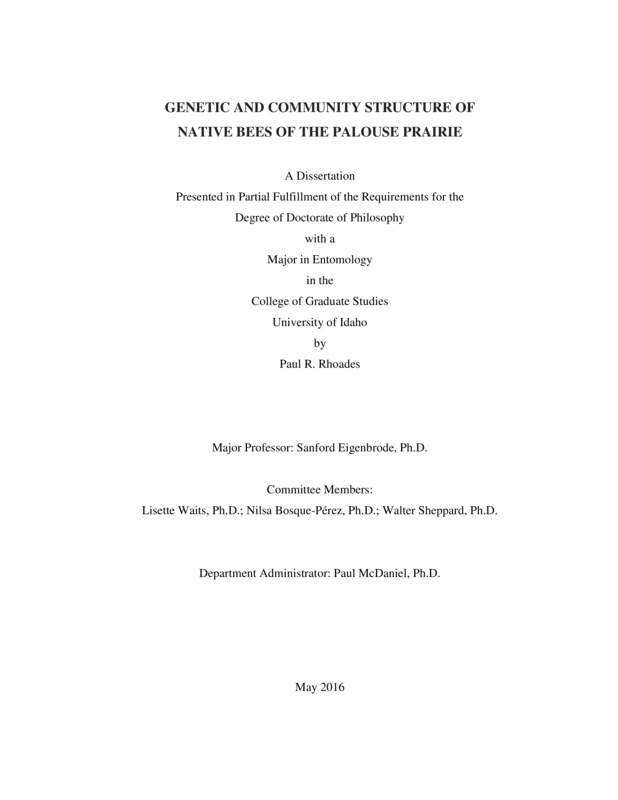Genetic and community structure of native bees of the Palouse Prairie
Rhoades, Paul R.. (2016). Genetic and community structure of native bees of the Palouse Prairie. Theses and Dissertations Collection, University of Idaho Library Digital Collections. https://www.lib.uidaho.edu/digital/etd/items/rhoades_idaho_0089e_10957.html
- Title:
- Genetic and community structure of native bees of the Palouse Prairie
- Author:
- Rhoades, Paul R.
- Date:
- 2016
- Keywords:
- bee habitat fragmentation invasive grass landscape ecology landscape genetics population genetics
- Program:
- Plant, Soil and Entomological Sciences
- Subject Category:
- Entomology; Ecology; Biology
- Abstract:
-
Many aspects of bee biology and conservation remain unresolved despite the crucial role bees play in both native plant and crop pollination. Bee communities associated with specific habitats are largely uncharacterized, the influence of changing land use, exotic grass invasion, and intensifying agriculture on bee populations and species is often unclear, and ways in which sampling techniques alter the detectability of habitat influence or bee functional classes are unevaluated. This thesis addresses knowledge gaps of bee biology and conservation in the inland Pacific Northwest with emphasis on the Palouse Region. Chapter 1 describes the bee fauna of Palouse Prairie fragments, including six state records and two range expansions, and provides community level information on bee species of unknown conservation status. Chapter 2 examines the presence and abundance of Bombus occidentals across the inland Pacific Northwest, where it was once common but now is rare. Chapter 3 compares three common bee collection methods and evaluates the response of bee communities collected using each method to habitat variables known to affect bees. The collection methods are also compared their detection of bees with different functional classes such as bee size or floral specialization. Chapter 4 compares the influence the amount of natural land, exotic grass invasion, and plant species richness and diversity on bee community metrics in the Palouse. Chapter 5 uses molecular markers to assess the genetic structure and permeability of different land cover types including intensive agriculture to dispersal and gene flow of Bombus bifarius. Chapter 6 describes an interdisciplinary study focused on conservation of Palouse Prairie plant communities, which are interdependent with bee communities of the region. Economic valuation of the cultural services provided by these communities can help motivate their conservation, but may be inadequate or insensitive to certain cultural perspectives. This final chapter, coauthored with other members of an interdisciplinary team of doctoral students, investigates the social value of culturally significant plants of the Palouse Prairie and evaluates the comfort people have with cash valuation of these plant communities. These results are relevant to bee conservation in fragmented grasslands surrounded by agriculture, a globally common land use pattern.
- Description:
- doctoral, Ph.D., Plant, Soil and Entomological Sciences -- University of Idaho - College of Graduate Studies, 2016
- Major Professor:
- Eigenbrode, Sanford
- Committee:
- Waits, Lisette; Bosque-Pérez, Nilsa; Sheppard, Walter
- Defense Date:
- 2016
- Identifier:
- Rhoades_idaho_0089E_10957
- Type:
- Text
- Format Original:
- Format:
- application/pdf
- Rights:
- In Copyright - Educational Use Permitted. For more information, please contact University of Idaho Library Special Collections and Archives Department at libspec@uidaho.edu.
- Standardized Rights:
- http://rightsstatements.org/vocab/InC-EDU/1.0/

